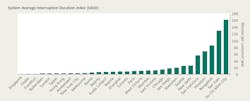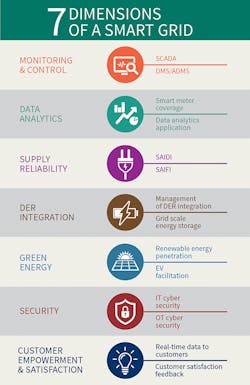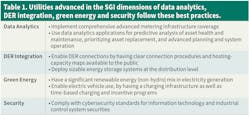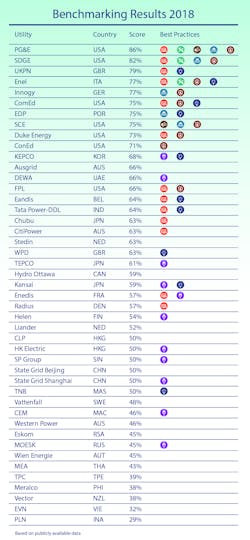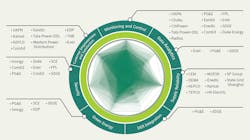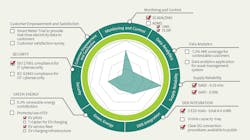Modernizing the power grid through smart grid enhancements is essential for the development of a smart city. A smart grid enables the city to be more sustainable by integrating distributed energy resources (DER), such as solar photovoltaics, wind turbines and energy storage systems, enabling the production of clean, sustainable and renewable energy close to where it is needed. The rapid growth of these DERs together with technological advancements is transforming the global power industry.
Declining costs and meeting green targets are driving the proliferation of DERs. Over the last decade, the cost of DERs has been reduced drastically, according to Bloomberg New Energy Finance (BloombergNEF). For example, solar energy now is cheaper than coal in some parts of the world and projected to represent 20% of the global energy consumption by 2040, up from 4% in 2015. Similarly, the price of Lithium-ion batteries has dropped by 80% over the last decade and is expected to fall an additional 52% by 2030.
The increasing integration of DERs into T&D networks presents new challenges for utilities as conventional grids have not been designed to handle bidirectional energy flow and the intermittent generating characteristics of DERs. These issues—coupled with challenges such as meeting green targets and changing customer demands and expectations—have driven utilities to transform existing grids into smart grids. What exactly makes a grid smart and how can this smartness be measured? The owner and operator of electricity and gas T&D businesses in Singapore, SP Group aimed to find out.
Smart Grid Index
Traditionally, the system average interruption duration index (SAIDI) and system average interruption frequency index (SAIFI) have been used as key performance indicators. However, for a smart grid, it is more than just delivering supply reliability. Integrating DERs, improving the grid’s resilience to cyber threats, accommodating behind-the-meter assets and allowing multidirectional power flows are some challenges utilities face. Reliability indices alone are no longer enough to measure grid performance and capabilities.
In the past three decades, benchmarking and target setting have been instrumental in SP Group achieving a high standard of reliability. However, recognizing the need for a more holistic approach prompted it to develop and launch the world’s first Smart Grid Index (SGI) for utilities.
The SGI framework examines and uses seven key dimensions derived from smart grid definitions, as defined by the European Commission and U.S. Department of Energy. The seven key dimensions are as follows:
- Monitoring and control
- Data analytics
- Supply reliability
- DER integration
- Green energy
- Security
- Customer empowerment and satisfaction.
These dimensions work together in a smart grid to deliver value to customers. For a grid to be smart, continuous awareness of its status is critical. Monitoring and control systems provide real-time network data, analysis of network operation and remote-operation capabilities.
The data can be analyzed and applied in asset planning and renewal, network operation and maintenance to improve overall operational efficiency. Moreover, certain real-time data, such as energy consumption and tariff information, can empower customers to make informed decisions that lower energy costs. Strengthening security also is critical to ensure supply reliability, for example, to prevent any cyber intrusion that could result in a prolonged outage and catastrophic outcome.
With the growing number of DERs being connected to the grid, integrating them without jeopardizing stability has become crucial for sustainable grid operation. The ability to integrate DERs to facilitate the use of green energy ultimately will bring greater benefits to customers.
SGI Assessment
The SGI assessment is designed to be simple and quantifiable. It balances precision and simplicity. Using publicly available information, the SGI addresses proxies of each dimension and diagnoses strengths and weaknesses of a utility’s smart grid development. Utilities can leverage the index to gain stakeholder buy-in and justify their business plans for smart grid development. Best practices from peer utilities also can be identified from the benchmarking results, promoting sharing of best practices through utility engagements.
SP Group found the SGI framework to be useful for planning its own smart grid development and road map, so it proceeded to share its findings at various international conferences throughout 2018 and 2019. These included the Conference of Power and Electricity Supply Industry (CEPSI), ASEAN Energy Business Forum (AEBF), BloombergNEF Summit in Shanghai, IEEE Power & Energy Society GTD Asia and International Conference for Energy System Integration (ICESI).
Feedback gathered at these conferences generally has been positive. Many observed the SGI is a fair reflection of their smart grid development. Others sought to work closely with SP Group to improve their ranking. One representative from a government department requested to include its country’s municipally owned distribution utilities in the SGI benchmarking. Some vendors and consultants indicated they see business opportunities and value in translating the findings into their research and development road map.
Global Benchmarking Study
Benchmarking was carried out on 45 utilities from 30 countries to develop the SGI. Utilities included in the study were selected based on the following criteria:
- Global coverage, including Asia-Pacific, Europe and the Americas
- Known to have embarked on the smart grid journey
- Availability of published data.
The study showed most of the utilities do well in the dimensions of monitoring and control, supply reliability, and customer empowerment and satisfaction. These utilities have an outage management system (OMS), fault location isolation and supply restoration (FLISR), a distribution management system (DMS) or an advanced distribution management system (ADMS) to manage their network effectively. Many of them have high reliability, with a SAIDI of less than 10 minutes. A few even have a SAIDI of less than 1 minute.
In addition, many of the utilities studied use advanced metering technology and provide real-time energy consumption data and tariff signals to their customers. This enables them to make informed decisions about their energy consumption.
However, the study also revealed fewer of the utilities do well in the other four dimensions: data analytics, DER integration, green energy and security. Generally, utilities that do well in these areas are from America and Europe. This finding is not surprising, as utilities in those locations/localities were faced with the challenges of disruptive technologies earlier than their Asia-Pacific counterparts. Utilities in Asia-Pacific likely will catch up in these dimensions as they progressively face similar challenges.
Development Project
SP Group scores particularly well in supply reliability, with a SAIDI of 0.23 minutes/customer/year and a SAIFI of 0.006 interruptions/customer/year. It has a DMS that uses artificial intelligence for contingency plans and supply restoration. It also has obtained ISO/IEC 27001:2003 for information technology (IT) cybersecurity.
However, there is still much room for improvement. Based on the study, SP Group identified opportunities and kicked off some development projects. For example, it currently is assessing how to deploy hosting capacity maps and a DER management system (DERMS) to accommodate and manage the growing number of DERs in Singapore.
SP Group’s current portfolio of development projects includes the following examples, designed to enhance system reliability and the smart grid status of the T&D network in Singapore:
- Building an underground transmission cable tunnel, slated to be completed in 2019
- Installing Singapore’s largest and fastest electric vehicle charging network, with 1000 charging points, scheduled for completion in 2020
- Establishing (with Singapore’s Housing and Development Board) the country’s first smart energy town in Tengah, which will integrate a wide range of energy solutions, including residential cooling to help customers save energy and costs
- Planning to build Singapore’s first experimental urban multi-energy microgrid on the Singapore Institute of Technology’s campus, with a target to achieve zero emissions.
Evolving SGI
The power industry is changing faster than ever, and technologies are evolving rapidly. New systems and processes for smart grids will continue to be developed. The smart grid assessment considered holistic today may not be regarded as comprehensive in the future. Even the assessment methodology of the SGI will need to evolve with time and adopt new criteria to keep up with the developments and adoption of new technologies. For example, some utilities are piloting DERMS technologies. When DERMS is adopted widely, it may be included as part of the SGI criteria.
The SGI is a tool for policy makers, utilities and other companies that want to drive smart grid development. Updated annually, the SGI benchmarking results—with utility rankings and best practices—serves to encourage utilities to innovate and invest in developing smarter grids.
For more information:
SP Group | www.spgroup.com.sg
Smart Grid Index Disclaimer
SP Group arrived at the findings, opinions and conclusions in this article based on application of its methodology to materials and information that are publicly available. The utility believes it to be accurate and reliable at the time the relevant research and study was undertaken. However, the materials and information may include inaccuracies and errors. The findings, opinions and conclusions must be construed solely as statements of opinion only on the matters addressed in this article, including the degree of grid smartness ratings and shall not, in any way, represent an authoritative assessment or judgment on any such matters. SP Group does not represent, warrant, undertake or guarantee the use of such findings, opinions and conclusions in this article will lead to any particular outcome or result. You, therefore, assume the sole risk of making use and/or relying on the findings, opinions and conclusions made available in this article. To the extent permitted by law, SP Group disclaims liability to any person or entity for all and any liability, direct and indirect, special, consequential, incidental losses and damages whatsoever arising from or in connection with your access to or use of the findings, opinions and conclusions in this article.

